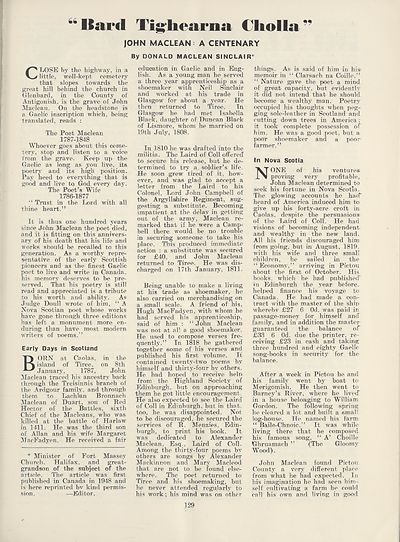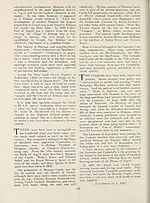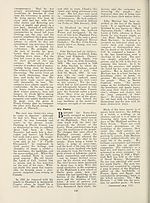An Comunn Gàidhealach Publications > Gaidheal > Volumes 44--45, January 1949--December 1950
(485) Page 129
Download files
Complete book:
Individual page:
Thumbnail gallery: Grid view | List view

Bard Tig-hearna Choi la **
JOHN MACLEAN A CENTENARY
By DONALD MACLEAN SINCLAIR*
CLOSE by the highway, in a
little, well-kept cemetery
that slopes towards the
great hill behind the church in
Glenbard, in the County of
Antigonish, is the grave of John
Maclean. On the headstone is
a Gaelic inscription which, being
translated, reads :
The Poet Maclean
1787-1848
Whoever goes about this ceme¬
tery, stop and listen to a voice
from the grave. Keep up the
Gaelic as long as you live, its
poetry and its high position.
Pay heed to everything that is
good and live to God every day.
The Poet’s Wife
1786-1877
“ Trust in the Lord with all
thine heart.”
It is thus one hundred years
since John Maclean the poet died,
and it is fitting on this annivers¬
ary of his death that his life and
works should be recalled to this
generation. As a worthy repre¬
sentative of the early Scottish
pioneers and as the finest Gaelic
poet to live and write in Canada,
his memory deserves to be pre¬
served. That his poetry is still
read and appreciated is a tribute
to his worth and ability. As
Judge Doull wrote of him, “ A
Nova Scotian poet whose works
have gone through three editions
has left a monument more en¬
during than have most modern
writers of poems.”
Early Days in Scotland
BORN at Caolas, in the
island of Tiree, on 8th
January, 1787, John
Maclean traced his ancestry hack
through the Treisinnis branch of
the Ardgour family, and through
them to Lachlan Bronnach
Maclean of Duart, son of Red
Hector of the Battles, sixth
Chief of the Macleans, who was
killed at the battle of Harlaw
in 1411. He was the third son
of Allan and his wife Margaret
MacFadyen. He received a fair
* Minister of Fort Massey
Church, Halifax, and great-
grandson of the subject of the
article. The article was first
published in Canada in 1948 and
is here reprinted bv kind permis¬
sion. -^Editor.
education in Gaelic and in Eng¬
lish. As a young man he served
a three year apprenticeship as a
shoemaker with Neil Sinclair
and worked at his trade in
Glasgow for about a year. He
then returned to Tiree. In
Glasgow he had met Isabella
Black, daughter of Duncan Black
of Lismore, whom he married on
19th July, 1808.
In 1810 he was drafted into the
militia. The Laird of Coll offered
to secure his release, but he de¬
termined to try a soldier’s life.
He soon grew tired of it, how¬
ever, and was glad to accept a
letter from the Laird to his
Colonel, Lord John Campbell of
the Argyllshire Regiment, sug¬
gesting a substitute. Becoming
impatient at the delay in getting
out of the army, Maclean re¬
marked that if he were a Camp¬
bell there would be no trouble
in securing someone to take his
place. This produced immediate
action : a substitute was secured
for £40, and John Maclean
returned to Tiree. He was dis¬
charged on 17th January, 1811.
Being unable to make a living
at his trade as shoemaker, he
also carried on merchandising on
a small scale. A friend of his,
Hugh MacFadyen, with whom he
had served his apprenticeship,
said of him : “ John Maclean
was not at all a good shoemaker.
He used to compose verses fre¬
quently.” In 1818 he gathered
together some of his verses and
published his first volume. It
contained twenty-two poems by
himself and thirty-four by others.
He had hoped to receive help
from the Highland Society of
Edinburgh, but on approaching
them he got little encouragement .
He also expected to see the Laird’
of Coll in Edinburgh, but in that,
too, he was disappointed. Not
to be discouraged, he secured the
services of R. Menzies, Edin¬
burgh, to print his book. It
was dedicated to Alexander
Maclean, Esq., Laird of Coll.
Among the thirty-four poems by
others are songs by Alexander
Mackinnon and Mary Macleod
that are not to be found else¬
where. The poet returned to
Tiree and his shoemaking, but
he never attended regularly to
his work ; his mind was on other
things. As is said of him in his
memoir in “ Clarsach na Coille,”
“ Nature gave the poet a mind
of great capacity, but evidently
it did not intend that he should
become a wealthy man. Poetry
occupied his thoughts when peg¬
ging sole-leather in Scotland and
cutting down trees in America ;
it took complete possession of
him. He was a good poet, but a
poor shoemaker and a poor
farmer.”
In Nova Scotia
NONE of his ventures
proving very profitable,
John Maclean determined to
seek his fortune in Nova Scotia.
The glowing accounts he hatf
heard of America induced him to
give up hie forty-acre croft in
Caolas, despite the persuasions
of the Laird of Coll. He had
visions of becoming independent-
and wealthy in the new land.
All his friends discouraged him
from going, but in August, 1819.
with his wife and three small
children, he sailed in the
“Economy,” arriving in Pictou
about the first of October. His
books, which he had published"
in Edinburgh the year before,
helped finance his voyage to
Canada. He had made a con¬
tract with the master of the ship
whereby £27 6 Od. was paid in
passage-money for himself and
family, and in addition the master
guaranteed the balance oF
£33 6 Od. due the printer, re¬
ceiving £23 in cash and taking
three hundred and eighty Gaelic
song-books in security for the
balance.
After a week in Pictou he and
his family went by boat to
Merigomish. He then went to
Barney’s River, where he lived
in a house belonging to William
Gordon. The following spring
he cleared a lot and built a small
log-house. He named his farm
“ Baile-Chnoic.” It was while
living there that he composed
his famous song, “ A’ Choille
Ghruamach ” (The Gloomy
Wood).
John Maclean found Pictou
County a very different place
from what he had expected. In
his imagination he had seen him¬
self cultivating a farm he could
call his own and living in good
)29
JOHN MACLEAN A CENTENARY
By DONALD MACLEAN SINCLAIR*
CLOSE by the highway, in a
little, well-kept cemetery
that slopes towards the
great hill behind the church in
Glenbard, in the County of
Antigonish, is the grave of John
Maclean. On the headstone is
a Gaelic inscription which, being
translated, reads :
The Poet Maclean
1787-1848
Whoever goes about this ceme¬
tery, stop and listen to a voice
from the grave. Keep up the
Gaelic as long as you live, its
poetry and its high position.
Pay heed to everything that is
good and live to God every day.
The Poet’s Wife
1786-1877
“ Trust in the Lord with all
thine heart.”
It is thus one hundred years
since John Maclean the poet died,
and it is fitting on this annivers¬
ary of his death that his life and
works should be recalled to this
generation. As a worthy repre¬
sentative of the early Scottish
pioneers and as the finest Gaelic
poet to live and write in Canada,
his memory deserves to be pre¬
served. That his poetry is still
read and appreciated is a tribute
to his worth and ability. As
Judge Doull wrote of him, “ A
Nova Scotian poet whose works
have gone through three editions
has left a monument more en¬
during than have most modern
writers of poems.”
Early Days in Scotland
BORN at Caolas, in the
island of Tiree, on 8th
January, 1787, John
Maclean traced his ancestry hack
through the Treisinnis branch of
the Ardgour family, and through
them to Lachlan Bronnach
Maclean of Duart, son of Red
Hector of the Battles, sixth
Chief of the Macleans, who was
killed at the battle of Harlaw
in 1411. He was the third son
of Allan and his wife Margaret
MacFadyen. He received a fair
* Minister of Fort Massey
Church, Halifax, and great-
grandson of the subject of the
article. The article was first
published in Canada in 1948 and
is here reprinted bv kind permis¬
sion. -^Editor.
education in Gaelic and in Eng¬
lish. As a young man he served
a three year apprenticeship as a
shoemaker with Neil Sinclair
and worked at his trade in
Glasgow for about a year. He
then returned to Tiree. In
Glasgow he had met Isabella
Black, daughter of Duncan Black
of Lismore, whom he married on
19th July, 1808.
In 1810 he was drafted into the
militia. The Laird of Coll offered
to secure his release, but he de¬
termined to try a soldier’s life.
He soon grew tired of it, how¬
ever, and was glad to accept a
letter from the Laird to his
Colonel, Lord John Campbell of
the Argyllshire Regiment, sug¬
gesting a substitute. Becoming
impatient at the delay in getting
out of the army, Maclean re¬
marked that if he were a Camp¬
bell there would be no trouble
in securing someone to take his
place. This produced immediate
action : a substitute was secured
for £40, and John Maclean
returned to Tiree. He was dis¬
charged on 17th January, 1811.
Being unable to make a living
at his trade as shoemaker, he
also carried on merchandising on
a small scale. A friend of his,
Hugh MacFadyen, with whom he
had served his apprenticeship,
said of him : “ John Maclean
was not at all a good shoemaker.
He used to compose verses fre¬
quently.” In 1818 he gathered
together some of his verses and
published his first volume. It
contained twenty-two poems by
himself and thirty-four by others.
He had hoped to receive help
from the Highland Society of
Edinburgh, but on approaching
them he got little encouragement .
He also expected to see the Laird’
of Coll in Edinburgh, but in that,
too, he was disappointed. Not
to be discouraged, he secured the
services of R. Menzies, Edin¬
burgh, to print his book. It
was dedicated to Alexander
Maclean, Esq., Laird of Coll.
Among the thirty-four poems by
others are songs by Alexander
Mackinnon and Mary Macleod
that are not to be found else¬
where. The poet returned to
Tiree and his shoemaking, but
he never attended regularly to
his work ; his mind was on other
things. As is said of him in his
memoir in “ Clarsach na Coille,”
“ Nature gave the poet a mind
of great capacity, but evidently
it did not intend that he should
become a wealthy man. Poetry
occupied his thoughts when peg¬
ging sole-leather in Scotland and
cutting down trees in America ;
it took complete possession of
him. He was a good poet, but a
poor shoemaker and a poor
farmer.”
In Nova Scotia
NONE of his ventures
proving very profitable,
John Maclean determined to
seek his fortune in Nova Scotia.
The glowing accounts he hatf
heard of America induced him to
give up hie forty-acre croft in
Caolas, despite the persuasions
of the Laird of Coll. He had
visions of becoming independent-
and wealthy in the new land.
All his friends discouraged him
from going, but in August, 1819.
with his wife and three small
children, he sailed in the
“Economy,” arriving in Pictou
about the first of October. His
books, which he had published"
in Edinburgh the year before,
helped finance his voyage to
Canada. He had made a con¬
tract with the master of the ship
whereby £27 6 Od. was paid in
passage-money for himself and
family, and in addition the master
guaranteed the balance oF
£33 6 Od. due the printer, re¬
ceiving £23 in cash and taking
three hundred and eighty Gaelic
song-books in security for the
balance.
After a week in Pictou he and
his family went by boat to
Merigomish. He then went to
Barney’s River, where he lived
in a house belonging to William
Gordon. The following spring
he cleared a lot and built a small
log-house. He named his farm
“ Baile-Chnoic.” It was while
living there that he composed
his famous song, “ A’ Choille
Ghruamach ” (The Gloomy
Wood).
John Maclean found Pictou
County a very different place
from what he had expected. In
his imagination he had seen him¬
self cultivating a farm he could
call his own and living in good
)29
Set display mode to:
![]() Universal Viewer |
Universal Viewer | ![]() Mirador |
Large image | Transcription
Mirador |
Large image | Transcription
| An Comunn Gàidhealach > An Comunn Gàidhealach Publications > Gaidheal > Volumes 44--45, January 1949--December 1950 > (485) Page 129 |
|---|
| Permanent URL | https://digital.nls.uk/127127856 |
|---|
| Description | This contains items published by An Comunn, which are not specifically Mòd-related. It includes journals, annual reports and corporate documents, policy statements, educational resources and published plays and literature. It is arranged alphabetically by title. |
|---|
| Description | A collection of over 400 items published by An Comunn Gàidhealach, the organisation which promotes Gaelic language and culture and organises the Royal National Mòd. Dating from 1891 up to the present day, the collection includes journals and newspapers, annual reports, educational materials, national Mòd programmes, published Mòd literature and music. |
|---|---|
| Additional NLS resources: |
|

